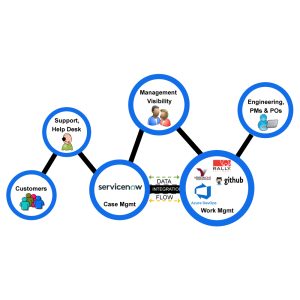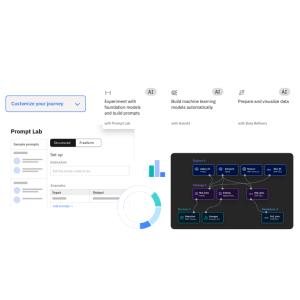In financial services, precision is non-negotiable. Whether it’s analyzing regulatory reports, processing high-volume trades, or assisting clients through natural language interfaces, the expectations for accuracy, context-awareness, and trust are higher than in almost any other industry.
Large Language Models (LLMs) have shown promise across many domains, but financial services present a distinct set of challenges that off-the-shelf models can’t fully address. That’s where fine-tuning steps in—and with the power of IBM watsonx, institutions can finally tailor LLMs to meet their specific workflows, regulatory environments, and data sensitivities.
This blog breaks down how fine-tuning LLMs using IBM watsonx unlocks real value for banks, insurers, investment firms, and fintechs—and how Nexright helps you get there.
Why General-Purpose LLMs Don’t Fit the Financial Mold
Most general-purpose LLMs are trained on wide-ranging internet data. While they excel at generating grammatically correct sentences and casual interactions, they fall short in scenarios that demand domain-specific knowledge, compliance awareness, and data integrity.
Key Gaps in General Models:
- Lack of Financial Vocabulary and Jargon: From derivatives to REITs, financial terminology is often misunderstood or oversimplified by general LLMs.
- Inability to Adhere to Regulatory Constraints: Financial outputs must comply with regulations like FINRA, SEC, Basel III, or MiFID. General models aren’t trained with these guardrails.
- Low Interpretability and Auditability: In finance, every output should be explainable, especially in regulated functions like lending decisions or investment advice.
- No Institution-Specific Context: Generic models can’t understand internal taxonomies, data schemas, or documentation standards unique to a specific organization.
This is where fine-tuning becomes essential.
What is Fine-Tuning—and Why It Matters in Finance
Fine-tuning is the process of adapting a pre-trained LLM to a specialized dataset or domain, enhancing its ability to perform specific tasks more accurately and reliably. Instead of training from scratch, organizations can leverage a base model and customize it with their proprietary data and domain rules.
In financial services, fine-tuning allows firms to:
- Reduce hallucinations in financial document analysis
- Improve contextual understanding of industry-specific language
- Tailor outputs to reflect internal compliance standards
- Improve the accuracy of customer service interactions
Enter IBM watsonx: A Purpose-Built AI Platform for Enterprise Needs
IBM watsonx stands apart from other AI toolkits because it’s designed with enterprise use cases at its core. The platform offers a full-stack environment for data preparation, model training, fine-tuning, and governance—all under strict security and compliance standards.
Key Components of watsonx for Fine-Tuning:
- watsonx.ai – a studio for training, fine-tuning, and deploying foundation models
- watsonx.data – a data store optimized for high-performance AI workloads
- watsonx.governance – tools to ensure compliance, lineage, and transparency
With watsonx, financial institutions get the infrastructure and tools necessary to fine-tune LLMs safely, effectively, and with full control over their data and models.
Use Cases of Fine-Tuned LLMs in Financial Services
Let’s break down where fine-tuned LLMs can bring actual, measurable improvements across finance operations.
1. Automated Financial Document Summarization
Annual reports, earnings releases, and policy documents are information-dense. A fine-tuned model can summarize key insights from thousands of pages quickly and reliably.
- Extracts structured insights from unstructured data
- Understands context behind metrics and terminology
- Reduces analyst workload in investment research
2. Client Communication and Advisory Services
Chatbots or virtual advisors powered by fine-tuned LLMs can deliver more reliable and compliant financial guidance.
- Responds using firm-specific language and offerings
- Avoids speculative or unapproved statements
- Adheres to jurisdictional rules (e.g., disclaimers)
3. Regulatory Compliance Monitoring
Instead of manually parsing through complex regulatory updates, LLMs can automate analysis and map changes to internal policies.
- Detects potential compliance gaps
- Links new regulations to internal documents
- Speeds up impact assessments and documentation
4. Trade Reconciliation and Exception Handling
Financial transactions generate huge logs. LLMs can be trained to flag discrepancies, annotate errors, and suggest resolutions.
- Processes trade confirmations and flags mismatches
- Adds narrative explanations to exception reports
- Enhances collaboration across ops teams
5. Risk Modeling and Policy Analysis
Trained on historical risk reports and policy frameworks, LLMs can assist in drafting internal risk documentation or simulating outcomes under specific constraints.
- Generates first-draft reports for human review
- Identifies inconsistencies or outdated sections
- Recommends updates based on policy templates
Fine-Tuning Workflows with IBM watsonx: Step by Step
Implementing fine-tuning in a financial environment requires a structured approach, especially with sensitive data in play. IBM watsonx supports a secure and governed process that fits enterprise requirements.
Step 1: Identify the Target Use Case
Start with a business function that’s knowledge-intensive and repetitive. Examples: financial report summarization, compliance mapping, or chat response optimization.
Step 2: Curate High-Quality Domain-Specific Data
Use internal reports, transaction data, knowledge bases, and past communications. Annotated or tagged data is even better.
Step 3: Prepare the Data with watsonx.data
This step ensures the right formatting, access control, and cataloging of datasets. watsonx.data supports structured and unstructured data pipelines.
Step 4: Fine-Tune the Foundation Model
Using watsonx.ai, the model is fine-tuned to reflect the firm’s domain vocabulary, document styles, and required logic. Training is secure and explainable.
Step 5: Validate and Test Outputs
Run the fine-tuned model through real-world test cases and edge scenarios. watsonx.governance provides transparency, bias detection, and audit trails.
Step 6: Deploy with Guardrails
Deploy the model into production using APIs or integrate with your existing systems like CRM, compliance tools, or customer support platforms.
Key Considerations for Financial Institutions
While the capabilities are promising, there are unique responsibilities when implementing LLMs in finance.
- Model Explainability: Regulators and internal audit teams may require a clear rationale behind each output. Fine-tuned models need built-in mechanisms to justify responses.
- Data Privacy: watsonx provides enterprise-grade privacy protection. Still, organizations must ensure no personally identifiable information (PII) is used during training without consent or masking.
- Human Oversight: LLMs in finance should augment—not replace—human judgment. Fine-tuning improves performance, but human review remains a must in high-stakes scenarios.
- Ongoing Governance: LLMs evolve. Governance frameworks need to be in place for continuous monitoring, model drift detection, and performance audits. IBM watsonx.governance handles these responsibilities effectively.
Looking Ahead: The Strategic Advantage of LLM Fine-Tuning in Finance
The financial sector is moving towards a future where AI doesn’t just support decisions—it accelerates and improves them. Fine-tuned LLMs are a core part of that evolution. The benefits go beyond automation—they drive contextual understanding, compliance alignment, and domain expertise into digital workflows.
IBM watsonx brings the architecture, control, and capabilities needed to do this right. It’s not about racing to deploy the next chatbot. It’s about systematically building intelligence into your operations—with transparency and accountability built in.
Conclusion: Why Nexright is Your Partner for Fine-Tuning LLMs with watsonx
At Nexright, we understand the unique demands of financial services—tight regulations, high stakes, and complex data. We also understand the intricacies of IBM watsonx, from fine-tuning foundation models to deploying them with the right governance and integration.
We don’t offer generic solutions. We work with your data, your workflows, and your goals to build something that actually fits—and delivers value from day one.




